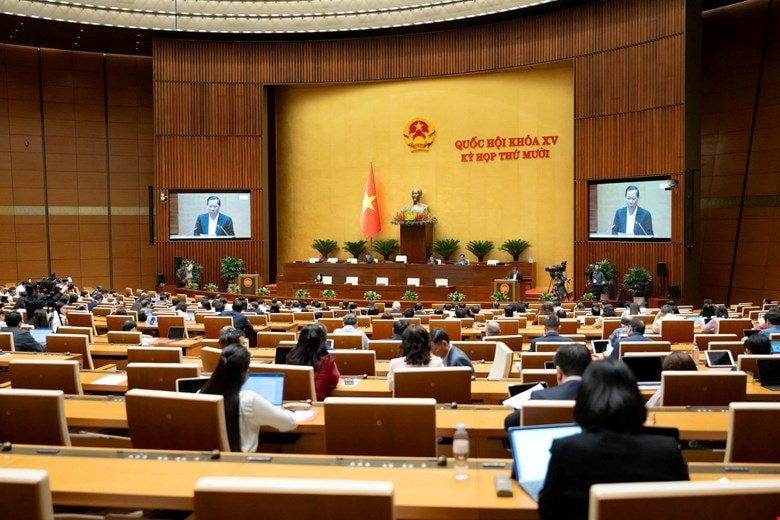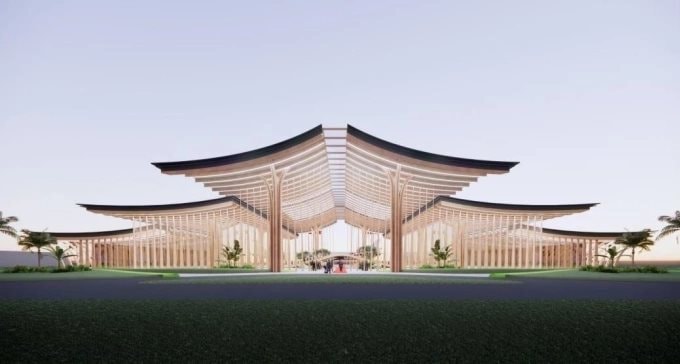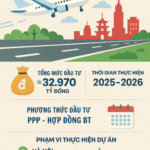This is the Gia Binh International Airport Construction Project (Gia Binh International Airport).
Accordingly, this morning (November 14), as part of the 10th Session’s agenda, the National Assembly heard a report on the investment policy for the Gia Binh International Airport Construction Project (in Bac Ninh province).
Presenting the Proposal on the investment policy for the Gia Binh International Airport Construction Project, Minister of Construction Tran Hong Minh stated that this project plays a crucial role in promoting a new growth pole in the eastern part of Hanoi. Furthermore, the new airport project aims to meet the increasing air transport demands of the Northern Key Economic Region, as well as to relieve pressure on and support Noi Bai International Airport, which is currently overloaded but cannot yet be expanded or upgraded.
In particular, according to the Minister, this project is also one of the infrastructure works selected for operation to serve the APEC 2027 Summit.
“Gia Binh International Airport holds special significance in ensuring national defense and security and serving the state’s foreign affairs events, especially the APEC 2027 Summit,” Minister Tran Hong Minh emphasized.
Detailed Investment Plan for Gia Binh International Airport

Minister of Construction presenting the Proposal on the investment policy for the Gia Binh International Airport Construction Project, November 14. Photo: VGP
To meet the above requirements, according to the Minister of Construction, the project investment must align with the National Master Plan for the 2021-2030 period, with a vision to 2050; the Master Plan for the Development of the National Airport Network for the 2021-2030 period, with a vision to 2050; the Master Plan for Gia Binh International Airport for the 2021-2030 period, with a vision to 2050; and the Bac Ninh Province Master Plan for the 2021-2030 period, with a vision to 2050.
Accordingly, the goal is to invest in constructing Gia Binh International Airport according to international standards, transforming it into a smart, green, sustainable, and world-class new-generation airport that meets the demands of socio-economic development, serves dual-use operations to ensure national defense and security activities, and supports important foreign affairs events, including the APEC 2027 Summit.
In particular, this airport also aims to achieve a 5-star international airport service standard, ranking among the top 10 5-star airports globally according to Skytrax criteria and among airports with excellent passenger experiences (AQS) as evaluated by the Airports Council International (ACI).
Additionally, Gia Binh International Airport aims to become the aviation gateway of the North, serving as a passenger and cargo transit airport and a maintenance, repair, and overhaul (MRO) facility for the Asia-Pacific region.

Perspective of Gia Binh International Airport. Photo: ĐVTK
According to the plan, Gia Binh International Airport is expected to be invested with a capacity of 4F as per the standards of the International Civil Aviation Organization (ICAO). The project will meet the demand for approximately 30 million passengers per year and 1.6 million tons of cargo per year by 2030, and around 50 million passengers per year and 2.5 million tons of cargo per year by 2050.
The project is expected to use over 1,800 hectares of land, including nearly 125 hectares for security, over 327 hectares for public use, and over 169 hectares for residential areas, affecting approximately 7,100 households (with plans to relocate about 5,800 households) and 118 organizations.
The total investment for Gia Binh International Airport is approximately 196,378 billion VND. This includes about 141,236 billion VND for Phase 1 and about 55,142 billion VND for Phase 2. The project will be funded by the investor’s capital, including equity and legally mobilized capital.
The Minister of Construction also stated that the project’s operational period is 70 years, from 2025 to 2095.
The Government proposes that the National Assembly consider approving the investment policy for the Gia Binh International Airport Construction Project, along with special policies to support the project’s investment. Additionally, it is necessary to assess the feasibility of meeting the timeline for serving the APEC 2027 Summit and to carefully study special mechanisms and policies for relocating historical and cultural sites to serve the project.
Need for Periodic Monitoring Every 5 Years to Update Revenue and Profit of the New Airport

Overview of the National Assembly session on the investment policy for the Gia Binh International Airport Construction Project. Photo: VGP
Reviewing this content, Chairman of the National Assembly’s Economic and Financial Committee Phan Van Mai stated that the Committee agrees with the necessity of investing in the project, as outlined in the Government’s Proposal.
However, the Chairman of the Economic and Financial Committee requested clarification on the feasibility and technical compatibility of the “dual-airport” and “multi-airport center” model for the Capital Region, especially regarding passenger and cargo flow allocation and airspace management, to ensure safety, efficiency, and synchronization in operations.
The Economic and Financial Committee also requested quantifying the project’s objectives, defining the roadmap and feasibility, and supplementing assessments of geology, hydrology, drainage, and the impact on the Ngu River. Additionally, clarification is needed on the investment plan for a multi-modal transportation system synchronized with the project’s completion timeline.

Perspective of the passenger terminal at Gia Binh International Airport. Photo: ĐVTK
Simultaneously, the Chairman of the Economic and Financial Committee requested an assessment of the feasibility of completing the project to meet the timeline for serving the APEC 2027 Summit, given the existing challenges related to compensation, support, resettlement, and complex geological conditions. Additionally, there is a need for plans to train, retrain, and create jobs for affected residents and solutions to ensure food security when a large area of double-crop rice land is reclaimed.
The Economic and Financial Committee also requested an analysis of the basis for determining the project’s 70-year operational period. Furthermore, it is necessary to determine this based on the actual capital recovery period and to establish periodic monitoring every 5 years to update revenue, costs, profits, and make flexible adjustments to ensure a balance of interests among the State, investors, and users.
Additionally, regarding the preliminary total investment, the Economic and Financial Committee requested clearer clarification of the calculation basis for the project’s investment rate, comparing it with similar airport projects in the region and adjusting it according to local prices to select an appropriate and optimal cost level.
Investing in the Development of Gia Bình International Airport to Meet Global Standards
Continuing the agenda of the 10th Session, this morning (November 14), the National Assembly heard a report on the investment policy for the Gia Binh International Airport Construction Project.
Inspectorate of Can Tho City Uncovers Series of Violations in Five Delayed Projects Across the Area
The Cần Thơ City Inspectorate has identified numerous limitations and shortcomings in the processes of planning, appraising, and approving detailed construction plans, land allocation, and more. These issues were particularly evident during the implementation of five projects within the city’s jurisdiction.













































